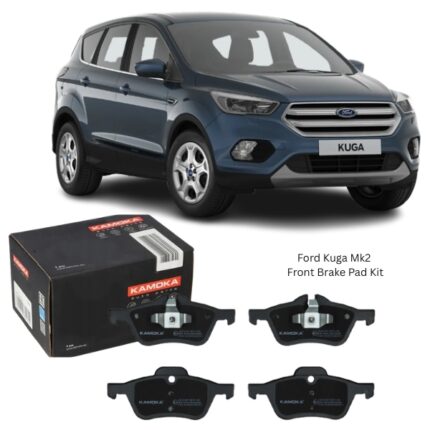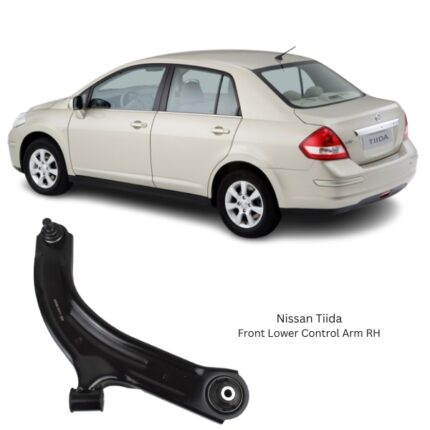Get VW Multivan T6 Front Brake Pad Kit JQ101434 in Kenya
The front brake pad kit is one of the most crucial elements of a vehicle’s braking system. It directly contributes to the safety, control, and overall performance of a vehicle. Designed to provide the necessary friction for slowing down or stopping a vehicle, front brake pads are typically subjected to the highest levels of stress and heat in the braking system, making their reliability and quality paramount.
A complete front brake pad kit includes all necessary components to replace the existing front brake pads efficiently. This typically comprises a set of brake pads (usually four—two per wheel), shims or anti-squeal plates, and in some cases, wear sensors, retaining clips, and lubrication grease. The goal of this complete kit is to ensure a quiet, smooth, and safe braking experience.
Function and Role in the Braking System
Front brake pads are housed within brake calipers, which are positioned on either side of the brake rotor. When the brake pedal is pressed, hydraulic pressure forces the caliper pistons to press the pads against the spinning rotor, creating friction. This friction converts kinetic energy into thermal energy, slowing the rotation of the wheels and, consequently, the vehicle.
Because the front of a vehicle carries more weight during braking—especially under sudden deceleration—the front brake pads handle a significant portion of the braking force, often up to 70%. This makes their performance and wear characteristics even more critical compared to rear brake pads.
Key Components of a Front Brake Pad Kit
-
Brake Pads (4 pcs): Usually consisting of an inner and outer pad for each front wheel. These pads are built with a friction material bonded to a metal backing plate. The composition of the friction material varies based on the intended application (daily driving, performance, off-road, etc.).
-
Anti-Squeal Shims or Plates: Thin layers of vibration-dampening materials attached to the backing plate. They help eliminate brake noise by reducing vibration between the pad and caliper.
-
Hardware Clips: Also known as abutment clips or pad retaining clips, these are used to hold the pads securely in the caliper bracket. Fresh hardware ensures proper fitment and prevents rattle or uneven wear.
-
Wear Sensors (optional): Some kits include electronic or mechanical wear indicators that alert the driver when the pad material reaches a minimum thickness.
-
Lubricating Grease (optional): High-temperature brake lubricant is sometimes included to be applied to contact points between the pad, caliper, and hardware to reduce noise and ensure smooth operation.
Types of Brake Pad Friction Material
The effectiveness and behavior of brake pads largely depend on the type of friction material used:
-
Semi-Metallic: Made from a combination of metals (such as steel, iron, copper) and friction modifiers. Known for good heat dissipation, high durability, and strong stopping power. They can produce more brake dust and may be noisier than other types.
-
Ceramic: Composed of ceramic fibers and nonferrous materials. Ceramic pads are quieter, produce less dust, and offer long-lasting performance. They are ideal for daily driving and offer smooth, consistent braking.
-
Organic (Non-Asbestos Organic – NAO): Made from natural materials like rubber, glass, and resins. They are soft and quiet but wear faster and may not perform as well under high heat or heavy loads.
Each material has its own advantages, and the choice depends on driving conditions, load demands, and desired performance characteristics.
Benefits of a Quality Front Brake Pad Kit
-
Consistent Braking Performance
High-quality pads ensure reliable stopping power under various conditions, including emergency braking, wet roads, and prolonged descents. -
Enhanced Safety
With proper friction levels and heat resistance, the pads maintain stopping distances and vehicle control—especially critical in high-speed or urban traffic scenarios. -
Reduced Brake Fade
Brake fade occurs when excessive heat reduces braking efficiency. Quality pads resist heat buildup and maintain effectiveness during repeated or prolonged braking. -
Quiet Operation
Well-engineered pads with anti-noise features such as shims and lubricated contact points minimize squealing and vibration. -
Longer Lifespan
Durable friction compounds and reinforced backing plates result in longer service intervals and reduced frequency of replacements. -
Smooth Pedal Feel
Balanced friction performance ensures smooth, linear pedal response, which contributes to driver confidence and comfort.
Common Signs of Worn Brake Pads
Brake pads wear out gradually and must be replaced when the friction material reaches a critical minimum thickness. Common signs of worn or failing front brake pads include:
-
Squealing or Screeching Noise: Often the result of metal wear indicators contacting the rotor surface.
-
Grinding Sound: Indicates complete wear of the pad material, exposing the backing plate and causing rotor damage.
-
Increased Stopping Distance: Worn pads reduce friction and increase the time needed to stop the vehicle.
-
Brake Pedal Pulsation: Uneven pad wear or heat spots can cause vibrations during braking.
-
Warning Light: In vehicles equipped with wear sensors, a dashboard alert may signal brake pad wear.
-
Visual Inspection: If the pad thickness appears less than 3mm, it’s time for replacement.
Regular inspections during routine service help catch these issues early and prevent further damage.
Installation and Replacement Guidelines
Replacing front brake pads is a relatively straightforward process for trained technicians or mechanically inclined individuals. General steps include:
-
Secure and Raise Vehicle: Place the vehicle on a flat surface, engage the parking brake, and raise the front end using a jack and jack stands.
-
Remove Front Wheels: Loosen the lug nuts and remove the front wheels to access the brake calipers.
-
Unbolt Caliper: Remove the caliper bolts and carefully lift the caliper away from the rotor.
-
Remove Old Pads and Hardware: Take out the worn pads and any old clips or shims.
-
Install New Pads and Hardware: Place the new pads in the caliper bracket, install new clips and shims as necessary, and apply brake grease at contact points.
-
Reassemble and Test: Reattach the caliper, mount the wheels, and pump the brake pedal several times before driving to ensure proper pad seating.
A break-in period (also known as bedding) is recommended after installation to allow the new pads to mate evenly with the rotors.
Maintenance Tips for Prolonged Pad Life
-
Drive Smoothly: Avoid aggressive braking when possible to minimize excessive heat and pad wear.
-
Keep the System Clean: Periodically clean caliper components and rotors to prevent buildup of debris or brake dust.
-
Inspect Rotors and Calipers: Uneven wear may be caused by sticking calipers or warped rotors.
-
Replace in Pairs: Always change front pads in sets to maintain balanced braking.
-
Flush Brake Fluid Periodically: Fresh fluid helps maintain hydraulic performance and protects components from internal corrosion.
Follow us on Facebook for more parts.





Reviews
Clear filtersThere are no reviews yet.